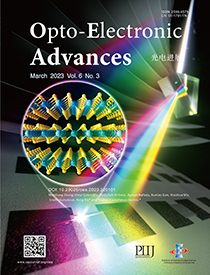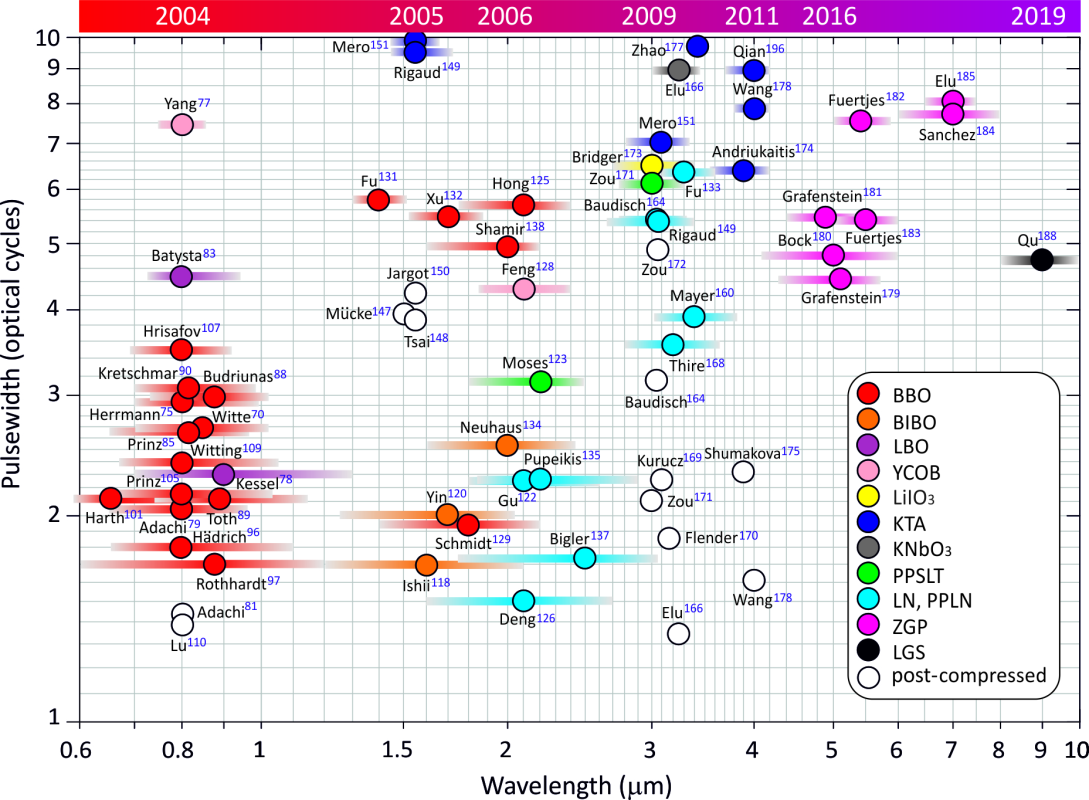Non-destructive periodic poling quality evaluation of MgO:PPLN and Rb:PPKTP crystals based on crystal translation and parametric light generation
 The work discloses a flexible, non-destructive, aberration-free, and automated periodic poling quality evaluation technique of the periodically poled crystals in the whole volume of the crystal with very high control and resolution. The method is based on a crystal translation in the directions perpendicular to the pump laser beam and the simultaneous recording of the parametric signal conversion efficiency in a simple single-pass parametric light generator setup. This technique allowed us to investigate and quantitatively describe the ferroelectric domain structure homogeneity of the periodically poled lithium niobate and potassium titanyl phosphate crystals with single, multi, and fan-out grating designs and offers a practicable overall efficiency assessment of the quasi-phase-matched device.
The work discloses a flexible, non-destructive, aberration-free, and automated periodic poling quality evaluation technique of the periodically poled crystals in the whole volume of the crystal with very high control and resolution. The method is based on a crystal translation in the directions perpendicular to the pump laser beam and the simultaneous recording of the parametric signal conversion efficiency in a simple single-pass parametric light generator setup. This technique allowed us to investigate and quantitatively describe the ferroelectric domain structure homogeneity of the periodically poled lithium niobate and potassium titanyl phosphate crystals with single, multi, and fan-out grating designs and offers a practicable overall efficiency assessment of the quasi-phase-matched device.

J. Banys, J. Pimpė, O. Balachninaite, V. Jarutis, J. Vengelis, Non-destructive periodic poling quality evaluation of MgO:PPLN and Rb:PPKTP crystals based on crystal translation and parametric light generation, Optik 277, 170686 (2023).

 High repetition rate femtosecond filaments in transparent solids produce conical third harmonic generation due to filament-induced material reorganization in the form of periodic volume nanogratings. Here we report on conical third harmonic generation that accompanies supercontinuum generation in fused silica using broadly tunable femtosecond pulses. The measurement of third harmonic cone angles with driving wavelengths in the 1–3-μm range fully supports the noncollinear phase-matching scenario that involves a reciprocal lattice vector of the filament-inscribed nanograting. The nanograting provides an octave-spanning phase-matching bandwidth, as attested by the measurements of the angle-resolved spectra of broadband conical third harmonic emission.
High repetition rate femtosecond filaments in transparent solids produce conical third harmonic generation due to filament-induced material reorganization in the form of periodic volume nanogratings. Here we report on conical third harmonic generation that accompanies supercontinuum generation in fused silica using broadly tunable femtosecond pulses. The measurement of third harmonic cone angles with driving wavelengths in the 1–3-μm range fully supports the noncollinear phase-matching scenario that involves a reciprocal lattice vector of the filament-inscribed nanograting. The nanograting provides an octave-spanning phase-matching bandwidth, as attested by the measurements of the angle-resolved spectra of broadband conical third harmonic emission.
 The generation of power- and wavelength-scalable few optical cycle pulses remains one of the major challenges in modern laser physics. Over the past decade, the development of table-top optical parametric chirped pulse amplification-based systems was progressing at amazing speed, demonstrating excellent performance characteristics in terms of pulse duration, energy, peak power and repetition rate, which place them at the front line of modern ultrafast laser technology. At present, table-top optical parametric chirped pulse amplifiers comprise a unique class of ultrafast light sources, which currently amplify octave-spanning spectra and produce carrier-envelope phase-stable, few optical cycle pulses with multi-gigawatt to multi-terawatt peak powers and multi-watt average powers, with carrier wavelengths spanning a considerable range of the optical spectrum.
The generation of power- and wavelength-scalable few optical cycle pulses remains one of the major challenges in modern laser physics. Over the past decade, the development of table-top optical parametric chirped pulse amplification-based systems was progressing at amazing speed, demonstrating excellent performance characteristics in terms of pulse duration, energy, peak power and repetition rate, which place them at the front line of modern ultrafast laser technology. At present, table-top optical parametric chirped pulse amplifiers comprise a unique class of ultrafast light sources, which currently amplify octave-spanning spectra and produce carrier-envelope phase-stable, few optical cycle pulses with multi-gigawatt to multi-terawatt peak powers and multi-watt average powers, with carrier wavelengths spanning a considerable range of the optical spectrum. 